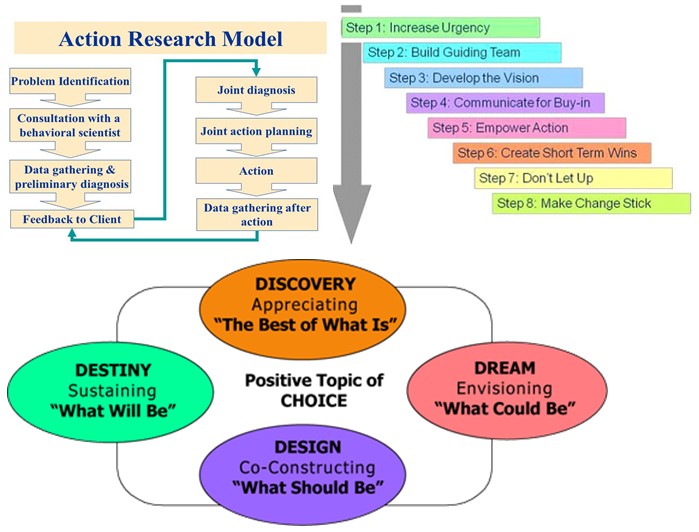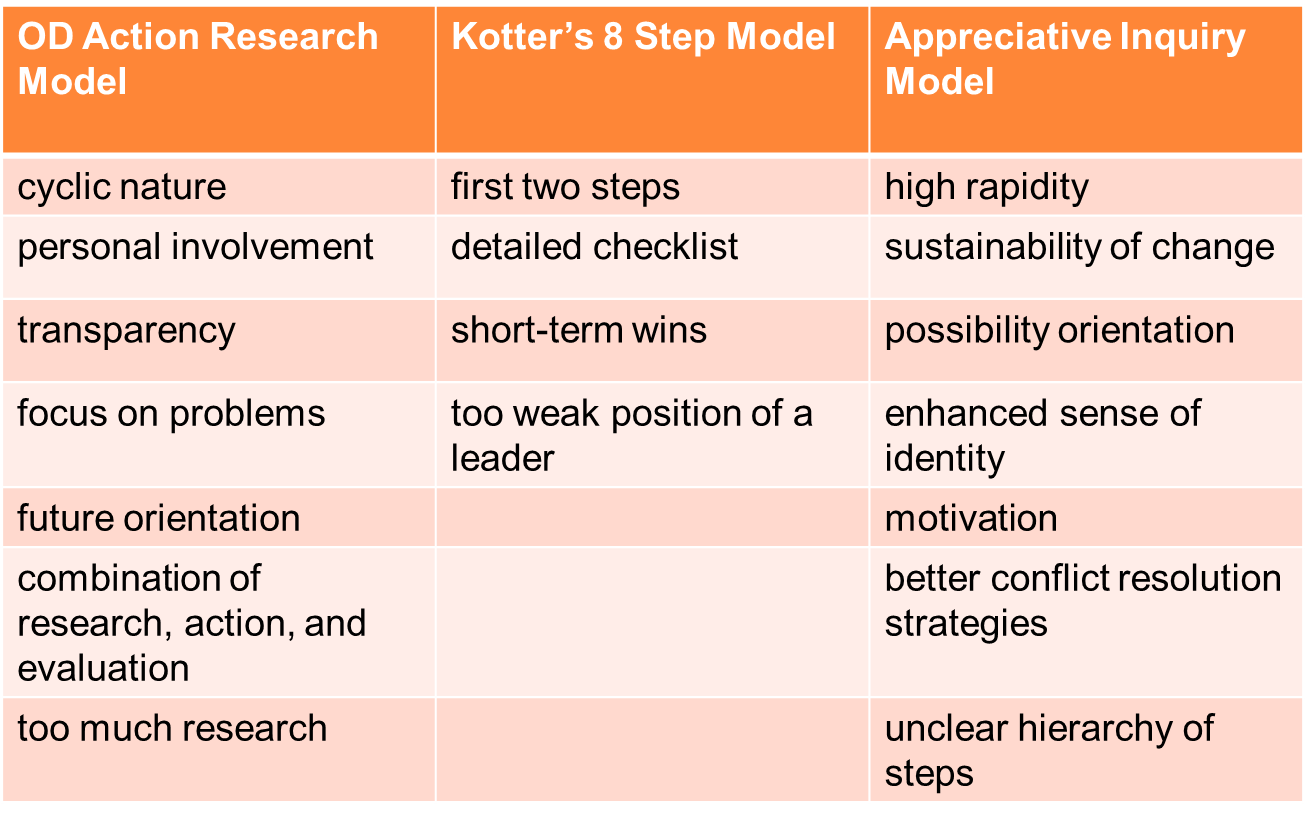OD Action Research Model Kotter’s 8-Step Model Appreciative Inquiry Model

The Action Research Model for Organization Development involves a continuous cycle of steps (Cameron & Green, 2015):
- Problem identification: the CEO of the organization must select those problems that can be solved with the assistance of an OD practitioner.
- Establishing the initial contact with a behavioral science expert. Both parties have to be aware of each other’s assumptions and values.
- Collection of necessary data by the OD practitioner (with the help of employees).
- Feedback to client.
- Coming to the agreement on what change has to be implemented.
- Performing joint action planning occurs.
- The beginning of the actual change that includes introductions of new policies and methods, reorganization, and reinforcement of new practices.
- Collection of data to identify how successful the change turned out to be.
Kotter’s 8 Step Model consists of the following steps (Cameron & Green, 2015):
- creating a sense of urgency to encourage the team to act immediately;
- building a coalition to control, coordinate, and communicate all actions;
- forming a strategic vision to foresee the future;
- enlisting a volunteer army;
- removing barriers to foster action;
- generating short-term objectives;
- sustaining acceleration.
Appreciative Inquiry Model involves four stages (Cameron & Green, 2015):
- The first, discovery stage, aims to find out the positive capacity of the organization and to highlight all factors that may lead to improvement.
- The second, dream stage focuses on discovering hidden values, needs, and strivings.
- Design step is creating a scenario and looking at how it may potentially work.
- Destiny stage is the one at which the future of the organization is decided and constructed as the implementation of change begins.
Pros and Cons of Each Model

The key benefit of the Action Research Model for Organization Development is in its cyclic nature, presupposing that each action is guided by the previous one. Furthermore, this model is problem-focused, future-oriented and stresses personal involvement of all the participants of the change process. The model is transparent: All parties have to be aware of assumptions and values of one another to establish an atmosphere that would be favorable for change. Finally, the approach makes it possible to combine action, research, and evaluation. The con is that too much attention is given to research (Cameron & Green, 2015).
The major advantage of Kotter’s model consists in its first two steps since any considerable change begins with the ability of a leader to convince employees that there is actually a need to launch the process of transformation. Thus, creating a sense of urgency and forming a guiding coalition means engaging a large group of people into one common activity. In many other models, these steps are overlooked since they mostly rely on the personality and initiative of the leader, who may not have all necessary insights and skills to start the changing process alone.
Another benefit is that the model provides a detailed checklist to make sure that everything is ready for the beginning of the change. Finally, it is very useful to create short-term wins for people to have a sense of achievement. Yet, the position of a leader is rather weak (Cameron & Green, 2015).
Appreciative inquiry model enables rapid, transformative and sustainable change, which is not problem- but possibility-focused. It enhances the sense of identity in participants helping them renew their motivation and commitment. Moreover, it suggests improved conflict resolution strategies (Cameron & Green, 2015). However, the model has an unclear sequence of steps.
Choice Justification
The majority of problems, which Red Carpet currently has to face, are connected with the company’s inability to manage its human resources. Employee relations are rather detached and it seems that top management is unable to organize collaborative work. Since the company is reputed as non-negotiable, it means that it is unlikely to be able to organize change in such a way that all interests will be taken into account. That is why it would be reasonable to suggest Appreciative Inquiry Model since it is based on collaborative inquiry of all stakeholders leading to a transformational change.
Since the company currently encounters numerous challenges, it is highly possible that problem focusing may discourage employees. The model will help find out the positive capacity of the organization and to highlight all factors that may lead to improvement. It will allow not only looking for experiences that show the best performance indicators but also noticing those that are surprising and may inspire managers and employees to see the situation from a different perspective and elicit positive discourse. Moreover, the model will open the blue sky potential to the company, neglecting real obstacles and restrictions. Employees will be involved in a lot of discussions and debate necessary to share discoveries and identify actionable ones among them, which will bring them closer as they will have to combine their efforts to carry out the developed change plan.
Overcoming Resistance to Change
Taking into account the attitude of the company’s top management to employees, there is a threat that overcoming resistance to change may turn into an endless losing battle since the current situation does not give any hopes that the employees will be eager to accept innovations. The company needs a proactive strategy to reduce resistance and gradually eliminate it. Here, leadership comes to the foreground as it is the task of a leader to inspire cultural shift and make people feel that their role in the ultimate success is crucial. In this case, all types of communication will have to be involved: The leader must be able to speak for a large audience as well as to organize effective personal meetings and disseminate plans and results via email. Resistance to change can be overcome through the following steps:
- structuring the team and dividing their roles and responsibilities to maximize the potential of each participant while giving opportunities for personal development within a team;
- setting achievable targets breaking the project into small milestones, which will allow celebrating completion and make the progress visible;
- resolving arising conflicts timely and effectively in order to avoid communicative breakdowns and establish the atmosphere of trust and mutual respect;
- showing passion and genuine belief in future improvements;
- being persuasive rather than asserting personal authority;
- empowering creativity and fostering contribution;
- being supportive and showing people that their personal concerns are important.
Reference
Cameron, E., & Green, M. (2015). Making sense of change management: A complete guide to the models, tools and techniques of organizational change. London, UK: Kogan Page Publishers.
